Menu
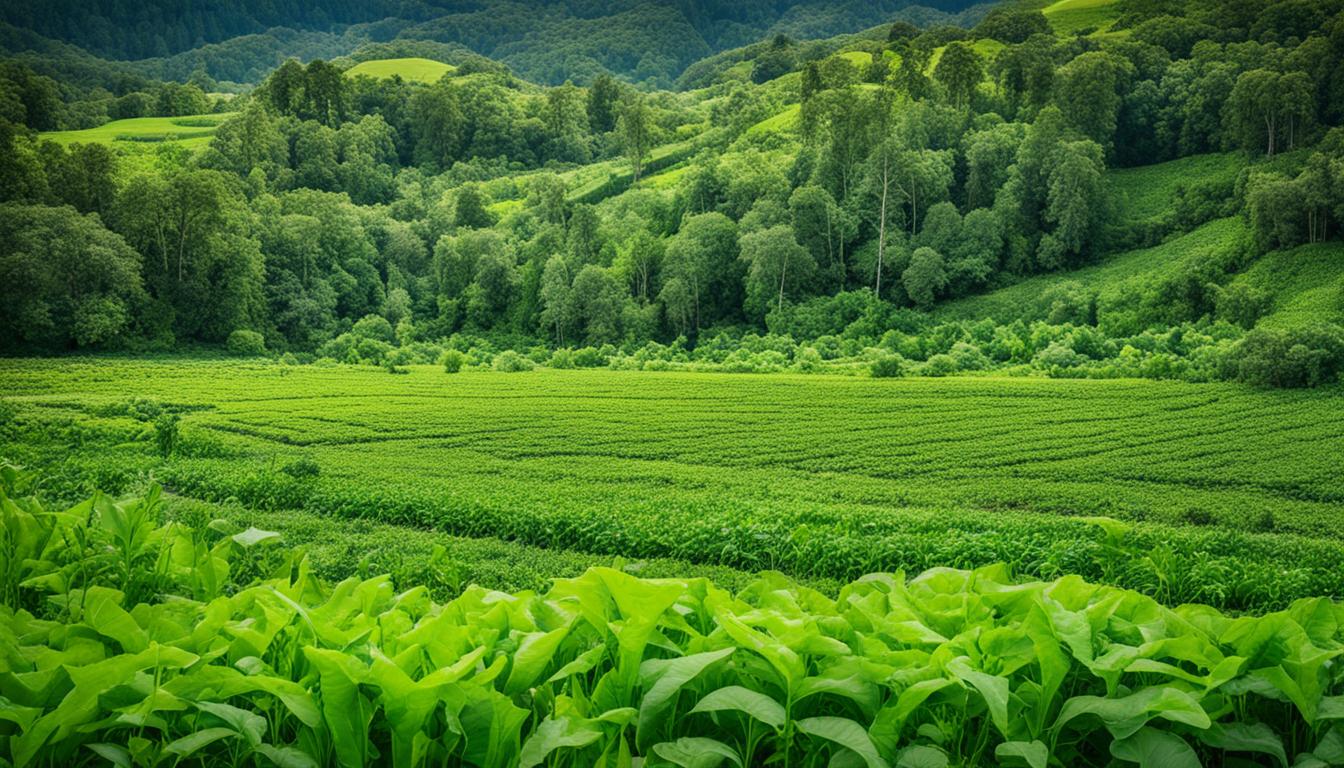
My early days in my grandmother’s garden linked me deeply to the soil. It went beyond planting and picking veggies. I saw a complex world teeming with life right below us. This bond taught me to always care for the planet’s diversity and soil.
Sustainable farming is key to keeping our planet healthy for the future. Today’s farming practices are like a lifeline for the earth. They help nutrients move, keep pests away, and fight diseases. Indeed, each bit of soil does a lot to help crops grow well and our environment thrive. This way of farming even saves water and keeps it clean.
The earth’s soil is teeming with life, crucial for vibrant farms and our well-being. It’s amazing how much life there is under our feet. This life boosts soil quality and enhances the services our ecosystems provide.
In the soil, there’s a rich mix of organisms like bacteria, fungi, and earthworms. Imagine, a single square meter of soil can be home to 9,000 different types of bacteria. Plus, it might have a million species of fungi. This diverse life is vital for recycling nutrients, keeping pests in check, and fighting diseases. Such diversity is key for healthy soil and sustainable farming.
Soil health impacts more than farming. It affects the air we breathe, the water we drink, and the food we eat. We look at things like soil texture, pH, and the presence of worms to gauge soil health. Keeping the soil in top condition helps plants grow better and cleans the air by capturing carbon. Right now, more than half of the world’s farm soil is suffering. This makes caring for our soil urgent through sustainable methods.
Spoil biodiversity offers big wins for our ecosystem services. For example, the ‘Resilient Highlands’ project in Guatemala shows how planting crops and trees can improve soil while offering benefits like natural pest control. This not only makes soil better but also helps with climate control and cleaner water. The Sustainable Agriculture and Land Health Initiative proves that we can farm productively while protecting biodiversity.
Keeping soil fertile is key to sustainable farming. We do this by making the soil healthier naturally. This ensures long-lasting productivity and keeps the environment in balance. It’s good for growing crops and for nature’s health, including fighting climate change.
Sustainable farming focuses on keeping the soil rich. It uses natural ways to keep the soil full of nutrients. Adding organic matter makes the soil better, helps it hold water, and supports tiny creatures living in it. Using natural fertilisers gives plants the nutrients they need without the bad effects of chemicals.
Adding things like compost and green manures helps a lot. They make the soil better by adding important nutrients. This lessens the need for harmful chemical fertilisers. It’s good for the planet, makes the soil healthier, and benefits what the farmers grow.

Crop rotation is a top method in sustainable farming. It stops pests and diseases naturally, needing fewer chemicals. It also keeps the soil healthy by balancing what plants take from it and what they give. For example, legumes like beans help by putting nutrients back into the soil. Plus, changing what’s planted helps keep the soil from washing away and lasts a long time.
Below is a table showing the pros of sustainable farming practices:
| Practice | Benefit |
|---|---|
| Organic Matter | Improves soil structure, water retention, and biodiversity |
| Natural Fertilisers | Provide essential nutrients, reduce pollution |
| Crop Rotation | Controls pests and diseases, enriches soil nutrients |
Soil erosion is a big problem that takes away a lot of soil and land. The Midwest, for example, has lost half its topsoil in the last 50 years. This leads to issues with environmental health and farming, costing the U.S. around $37.6 billion each year.
To stop soil erosion, we need good methods to keep the soil healthy. Let’s look at some effective ways:
In 2019, heavy spring rains in the Midwest caused major soil damage. Using soil-saving methods, we can protect the environment and keep our farms productive. These steps are key to a healthy future for agriculture.
Crop rotation is important too, mixing up the plants in a field to keep the soil rich. Strip cropping is another good method. It uses tall and short plants together to block the wind and add nutrients to the soil. Water is essential, and planting buffer strips along streams and rivers prevents water and soil from washing away. This keeps the water clean and the soil strong.
About 60 percent of the soil that gets washed away ends up in water, bringing harmful chemicals with it. This is why we really need to use these soil-saving methods. They are great for stopping soil erosion and making our environment healthier.
To sum up, taking care of our soil is crucial for fighting erosion. It not only makes the environment better, but it also helps our farms do well for the future.”>
Microbes in soil are crucial for its health and for good farming. They cycle nutrients well. They also help control pests naturally and reduce plant diseases.
Various types of microbes play a key role in how soil nutrients work. For example, Delgado-Baquerizo and team (2016) found that having many different microbes is good for the land. They help with things like turning nitrogen into forms plants can use and breaking down phosphorus. This makes sure there’s plenty of phosphorus for plants to grow well.
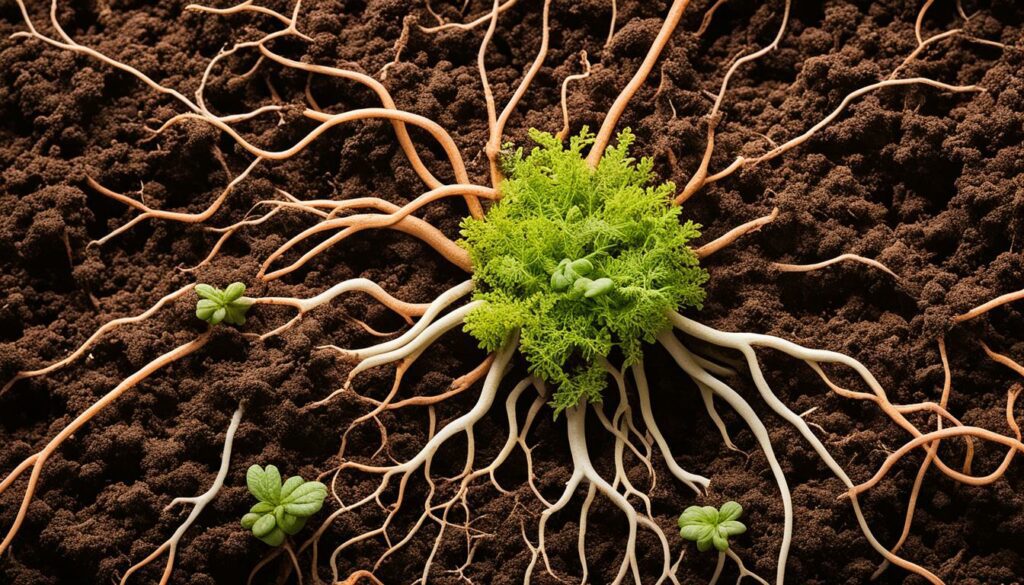
Microbes in the soil also help plants take in nutrients better, leading to bigger harvests. They can pull nitrogen from the air and give it to plants. This is a big help for farming, making it more productive without needing lots of chemical fertilisers.
Microbial communities keep pests in check and fight off plant diseases. Many studies show that the life forms in the soil are important for keeping crops healthy. This cuts down on the use of harmful pesticides, making farming safer for the planet.
Starke and others in 2019 talk about how special proteins from microbes boost soil health. Knowing how these tiny creatures work is key to healthier farms. This kind of pest control is gentle on the environment and makes crops stronger.
The following table summarises the key findings from various studies:
| Study | Focus | Key Findings |
|---|---|---|
| Van Leeuwen et al. (2019) | Soil function modelling | Emphasised soil biodiversity and habitat provisioning |
| Wagg et al. (2014) | Soil biodiversity | Key to ecosystem multifunctionality |
| Delgado-Baquerizo et al. (2016) | Microbial diversity | Driver of ecosystem multifunctionality |
| Bender et al. (2016) | Soil ecological engineering | Crucial for agricultural sustainability |
Understanding how microbes help with nutrients, pests, and diseases is key to smart farming. Taking care of the earth’s health means better and stronger farming for us and the future.
Healthy soils keep water well, lessening the need for lots of watering and cutting back on pollution. This is key in fighting water shortages and the effects of a changing climate around the world.
Soils rich in organic matter are great at holding water, and they help crops too. They give crops like corn lots of essential nitrogen; up to 250 pounds per acre. But, we must be careful. Too much nitrogen can leak into our water, which is bad for our health.
The type of soil directly affects how water moves. Sandy soils let water through quickly, which can carry harmful stuff into water sources. However, clay and silt soils can also cause problems. They can move nitrogen, phosphorus, and germs into water. But, doing things like adding organic material can make the soil better. This helps lower the risk of water pollution.
Having the right amount of organic material in soil matters a lot. About 58% of organic material is carbon. If we increase this material by one percent, soil can hold a lot more water. For example, this change could mean an extra 20,000 gallons of water per acre. That’s a big deal for keeping our environment healthy.
Choosing organic farming can make soils better. Organic farms have less nitrogen in their topsoil water than others. They also help with managing how water moves through the soil. This reduces the chances of floods and water running off. These ways protect our planet and the water we drink.
To keep water clean and make the soil good at holding it, using cover crops and changing what we plant is a smart move. These simple methods boost the amount of organic material in soil. This means we need less chemical fertiliser, which keeps our water clean. So, good soil not only helps us grow food but also care for the environment better.
It’s crucial to make our farms and food systems resilient as climates get more erratic. A key approach is using many types of crops. This helps the system stay productive, even when things change.
Having a variety of crops makes our farms tougher against changing weather. When ecosystems don’t have this variety, they struggle to cope with swings in weather, like extreme heat or rain. However, by mixing different crops, the system is more likely to keep working well. This stops problems from getting too big.
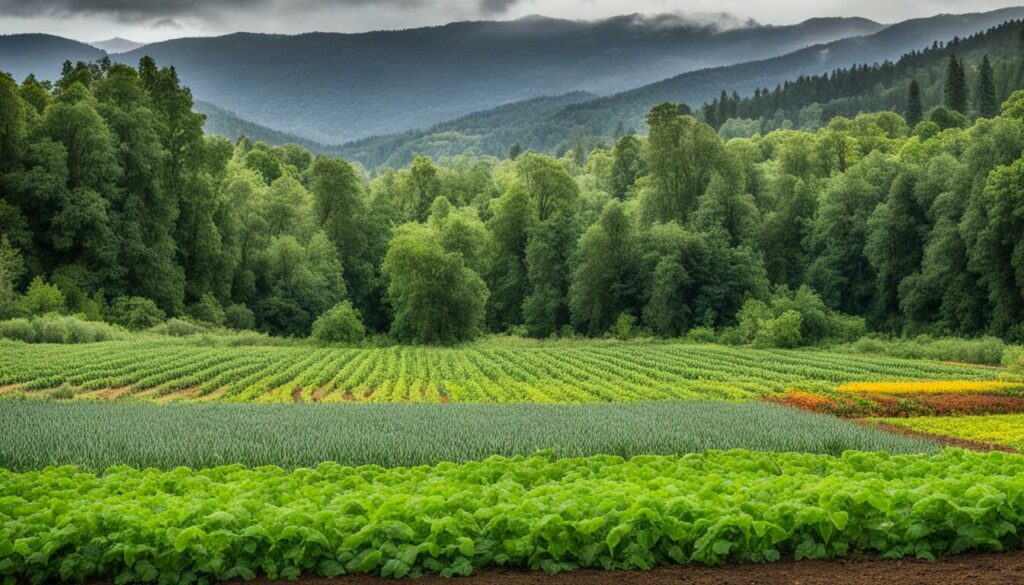
Growing different crops also means using fewer chemicals, which is great for the environment. Farms with lots of crop types can naturally control pests better, needing fewer chemicals. This is important because climate change will bring more pests.
Even though using fewer chemicals is good, it can be hard to convince farmers. This is because they might make less money or think it’s not as easy to farm. Still, in the long run, having many types of crops helps a lot more than it doesn’t.
Crop diversity doesn’t just help in the fields. It also makes the soil healthier by adding more nutrients. Different crops do this in various ways, making the soil better for each other. This makes the land good for farming over time, at many different levels.
By using these diverse systems, we get better at dealing with climate change. This means we not only help ourselves but also nature around us to keep going.
Sustainable farming helps keep our natural world alive and thriving. It protects the homes of many plants and animals. This way, it keeps our food coming and helps nature stay strong.
Certain farming methods, like changing crops and not disturbing the soil too much, do wonders for nature. They mean more plants and animals can live in and around farms. The United Nations warns that if things get too hot, lots of animals might not find a place to live. These methods are super important because farming takes up a big part of the land.
By farming the right way, we can keep rare animals and plants safe. Since the 1970s, the numbers of many kinds of animals and fish have fallen a lot. The worst hit areas are parts of Latin America and the Caribbean. Good farming can help create ‘safe zones’ where these life forms can grow.
“Feeding a population of 9 billion using current methods could result in converting an additional 1 billion hectares of natural habitat to agricultural production.”
Right now, all countries are working towards 20 goals to save nature. But we need to do more. Luckily, smart farming methods can help a lot. They not only save wildlife but also make the land healthier. This means less need for harmful chemicals. The good work of sustainable farming reaches far beyond the farms. It helps protect homes and animals for the kids of tomorrow.
Soil composition is key to ecosystem health and productivity. It’s made up of mineral particles, organic matter, water, air, and many living things. The right mix gives the soil the ability to support plant and animal life.

Soil structure starts with mineral particles. These come from rocks worn down over time. They include sand, silt, and clay. The type and amount of these particles affect how well the soil holds water, its drainage, and if plants get enough air. Balancing these particles is crucial for good soil health.
| Particle Type | Size Range (mm) | Properties |
|---|---|---|
| Sand | 0.05-2 | Good drainage, low nutrient retention |
| Silt | 0.002-0.05 | Moderate drainage, moderate nutrient retention |
| Clay | <0.002 | Poor drainage, high nutrient retention |
Organic matter is crucial for soil life and fertility. It comes from plant and animal remains, broken down by creatures like earthworms. This material holds water, adds nutrients, and supports tiny life forms. Methods like adding cover crops and avoiding ploughing help increase organic matter.
Water and air are vital for good soil. They help plants grow and support tiny creatures in the soil. Soil needs to hold water well but also let in air. This balance is key for healthy plants and soil life.
Soil is packed with life. Half of Earth’s biodiversity can be found in the soil. Creatures like earthworms and nematodes help break down material and keep nutrients cycling. Farming methods that protect these creatures, like crop rotation, are good for soil health and food production.
Knowing how to work with soil composition leads to better farming. This improves not just soil but also plant and animal diversity. For more about soil life and how to care for it, visit Colorado State University’s resources.
How we manage land has a big impact on soil health. It’s key for stopping soil damage and boosting how much we grow. For example, when we rotate crops and use cover crops, we help preserve soil life and make farming more eco-friendly.
Every year, around 24 billion metric tons of soil vanish due to factors such as erosion. It shows why good land management is crucial for keeping our soil healthy.
The health of the soil is at the centre of good land management. Adding different cover crops helps prevent the ground from being worn away. It also feeds soil life, which then turns dead materials into plant food and helps control pests, making our farms better.
The UN’s FAO made 2015–2024 the International Decade of Soils. This shows how important soil health is. It wants to get everyone thinking more about the ground under our feet and to push for better ways to take care of it.
We need to think more about soil to meet big environmental goals set by the UN. The health of the ground is affected by many things, like how we farm and what our environment is like. Doing things like heavy ploughing can mess up the tiny life forms that keep soil healthy.
| Indicator | Impact |
|---|---|
| Physical Disturbance | Disrupts soil microbes and compacts soil, affecting structure and health |
| Overgrazing | Leads to reduced root mass, increased runoff, and higher soil temperatures |
| Biodiversity Lack | Increases susceptibility to disease and pests |
| Cover Crops | Enhances soil health by improving structure, reducing erosion, and supporting microbial activity |
Having plants around all the time helps keep the soil’s most active zone healthy. Things like cover crops stop water loss, keep the soil at good temperatures, and help good bugs grow. This makes the whole farming system stronger and more balanced.
To sum up, good land management is crucial for soil health. Simple steps like swapping crops and using cover can stop bad things like erosion. They make the soil more solid, helping us all farm better and live in a greener world.
Healthy soils are key in the fight against climate change. They store carbon and cut down on greenhouse gases. To help, we must farm in ways that make our soils stronger. This can boost the health of our farms, helping the planet too.
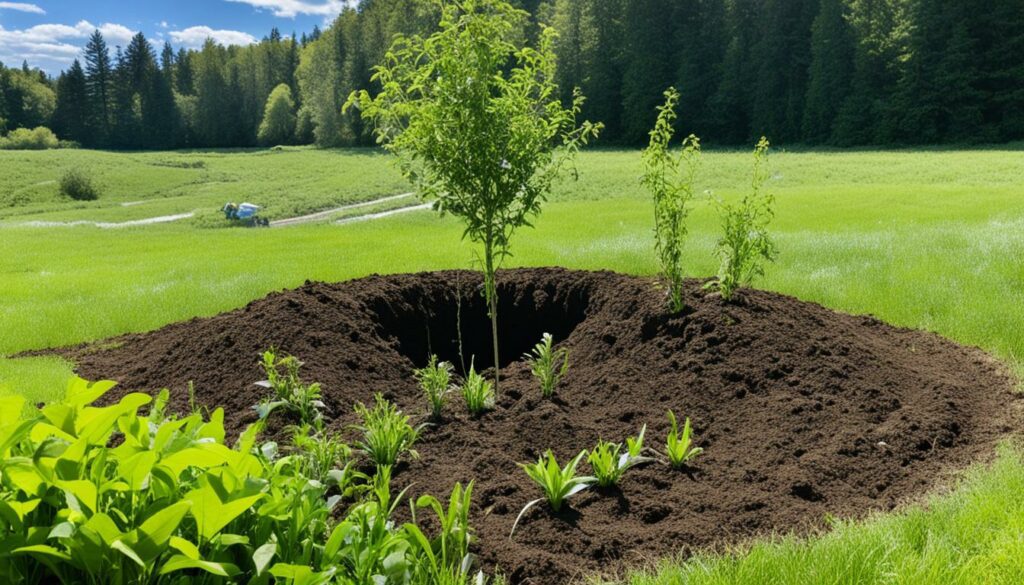
Soils trap carbon from the air, helping to lower greenhouse gas levels. Soil with fine textures can store more safe carbon than sandy soil can. Good soils can release over 60 mg of CO2, while poor ones release less than 30.
Ways to make soils better at trapping carbon include no-till farming. Using cover crops is also helpful.
| Parameter | Healthy Soil | Degraded Soil |
|---|---|---|
| Carbon Sequestration | High | Low |
| CO2 Release (mg/kg/day) | 60+ | |
| Economic Impact | Positive | Negative |
About a quarter of the world’s nitrous oxide emissions come from farming. To lessen this, we should disturb soils less and keep them covered and diverse. This means using less machinery and more natural ways to grow food.
Soil erosion worsens climate change. It happens when soil is lost, taking its stored carbon with it. Fixing even a small part of damaged land could help feed millions more people. It could also increase small farmers’ earnings and cut down on greenhouse gases.
Clearly, working to keep our soils healthy is vital for the planet. It’s a crucial step in our fight against climate change.
Efficient nutrient management is key in farming today. It boosts crop growth while looking after the earth. Using organic and natural fertilisers, modern farming methods, and keeping the soil’s pH right are all very important. They help us manage our nutrients well.
In nutrient management, organic fertilisers are very important. They give crops what they need and make the soil better. This matters a lot because better soil means healthier crops. And when crops are healthy, they grow strong. On top of this, things in the soil that are alive or have broken down helps the soil hold more of the good stuff needed by plants. Like nitrogen, phosphorus, and sulfur, which are critical for plant growth. So, using organic things in the soil is smart.
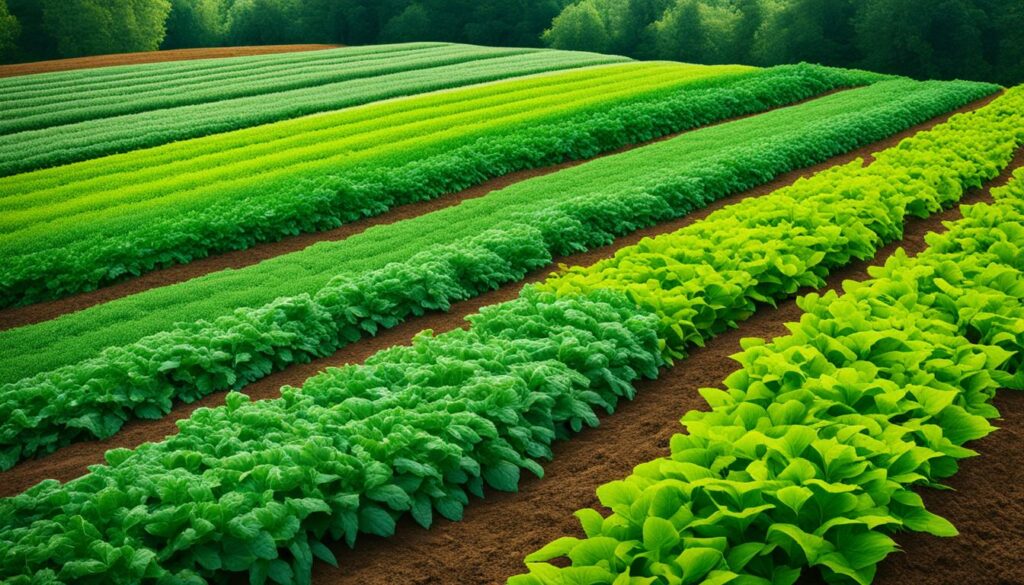
Precision agriculture uses technology to use things like water and fertilisers in a smarter way. This helps farms waste less and do better. More and more farmers are using this smart farming because it works well. It’s good for the environment, too. By applying the ‘4R’ approach, we make sure we use the right amount of the right stuff at the right time and place. This means crops get just what they need, making farms more productive and efficient.
Keeping the soil’s pH right is vital for plants to get the nutrients they need. The soil’s pH affects what tiny things live in it. And these tiny things help plants by breaking down nutrients they can’t get on their own. Depending on whether the soil is more acidic or alkaline, different nutrients become available. That’s why checking and sometimes adjusting soil pH is crucial for helping plants to grow well.
| Advantage | Benefit |
|---|---|
| Soil Organic Matter | Enhances water retention and nutrient supply |
| Precision Agriculture | Reduces wastage and increases productivity |
| Optimal Soil pH | Maximises nutrient availability and supports balanced soil health |
Water conservation in farming is key for using less water and protecting the environment. Ways like collecting rainwater and using drip systems are great for saving water.
In places like California, how you design landscapes matters a lot for using water wisely. Putting down things like compost and mulch really helps. The NRCS found that just adding 1% more organic matter to soil can help it hold 27,000 gallons of water per acre better.
Take California’s effort to add 3.2 million tonnes of compost a year, for example. It could help the soil hold an extra 3.7 billion gallons of water. These steps support both farming that can keep going and keeping our environment healthy. Also, a study in 2005 showed that using water in California uses a lot of energy.
Research funded by CalRecycle shows that using compost on burnt soils can cut down the loss of water by up to 90%. This proves how big an effect adding organic matter can have on water control.
Adding compost and mulch in places that need it most, like sandy areas, can really save water. This is especially important for growing crops that need lots of water, like orchards. Doing this helps use water smarter.
Many studies underline the value of caring for the land in a smart way. They say methods like no-till farming can stop soil from compacting and washing away. Planting cover crops can slow down rain, let water sink in, and fill up groundwater again.
Using flowering cover crops next to regular ones doesn’t just help birds and bugs. It also saves water. For example, almond farmers in California now plant special mixes of flowers. These mixes not only help the land but the farms stay healthy too.
Using local plants and crops that don’t need much water, such as maize, rice, and olives, helps cut water use. Changing the crops you grow every so often can also save water. Adding compost to the soil makes it hold water better, helping with good water use and farm care.
Farmers need help to embrace sustainable farming. They need to learn more, get offers from the agriculture sector, and have the local community behind them. This support is key to making these green practices work.
To fight climate change, farmers must learn about regenerative farming. They should know about methods like less ploughing, planting cover crops, and having animals on the farm. These changes can be difficult and costly at first. That’s why special education is crucial to help them overcome these start-up challenges.
Supporting farmers financially is crucial for them to go green. Different helps, like money from the government, tax deductions, and cash for their land’s environmental impact, ease the burden of initial costs. The encouragement continues with rewards for their environmental efforts. For example, the EQIP programme has been successful, helping farmers grow more cover crops in 2021 with financial and professional assistance.
It’s not just about the farmers; the whole community must be involved for success. A key point is clear communication and creating fair, stable markets that pay back for eco-friendly farming. Also, focusing on mental health and continuous learning for farmers is crucial. Combining money help, learning, and changing laws is how we can make green farming the best choice for farmers everywhere.
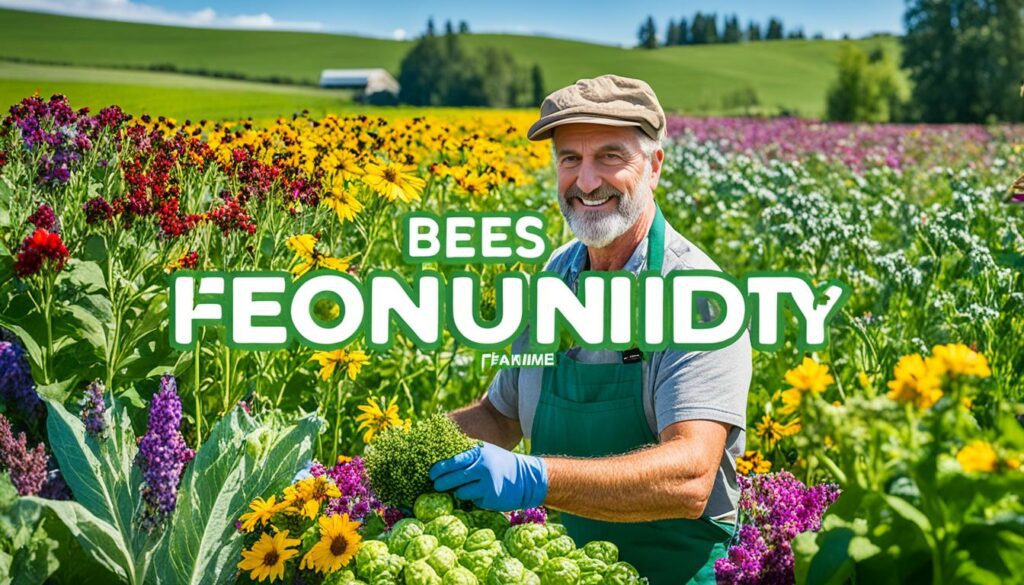
Sustainable agriculture is key for our future generations. It puts soil health and biodiversity first. This choice makes our farming more resistant and productive. It also protects the planet.
Experts like Bardgett & Van Der Putten (2014) and Clermont-Dauphin et al. (2014) agree. They say diverse soils are vital for farming success. Belowground life plays a big part in how an ecosystem works. It provides important services we often take for granted.
Healthy, diverse farms help us stay well. They lower our reaction to allergens and improve our digestion. Plus, they give us crops with good microbes in them. This can lead to better gut health.
And, let’s not forget soil’s role in making medicines. It grows plants used for antibiotics. Soil health can also fight off crop diseases, helping reduce hunger worldwide. Access to safe, healthy foods is vital in battling food insecurity and malnutrition.
Our food has become less varied, affecting our nutrition and health. Reversing this trend is crucial. By focusing on soil health and biodiversity, we not only heal the earth. We also boost our immunity, get essential nutrients, and provide medicines.
These steps lead towards farming that’s good for the planet and people. They create an agriculture system that’s both sustainable and thriving. By following these practices, we build a brighter future.
Biodiversity in soil helps it stay healthy. It does this by supporting many tiny organisms. These organisms help with many things like recycling nutrients, fighting pests, and stopping diseases.
It makes the soil more fertile. This helps not just the soil but also the climate and clean water.
Sustainable farming uses natural methods and materials. It keeps the soil healthy by using things like organic materials. It also rotates crops and adds plants to cover the soil.
These efforts keep the soil from wearing away. They also make it better at holding water and staying clean. It’s good for the environment around us.
Rich soil helps plants grow well. It has all the nutrients plants need. It uses natural ways to keep these nutrients. This helps keep the land productive year after year.
When different plants are grown, they give and take different things from the soil. Swapping plants helps to keep the soil full of what plants need. This also stops pests and diseases without chemicals.
There are good ways to stop soil washing away. No-till farming and covering the soil with plants are two. Using native plants also helps. They keep the soil strong and stop the land from becoming barren.
Small life in the soil does a lot. It helps with food, fights pests, and stops diseases. Thanks to these hard workers, we don’t always need chemicals. This keeps the soil and the world healthy.
Good soil keeps a lot of water. This means we don’t need to use as much to water our plants. It also stops dirty water from running off into rivers. This is very important in fighting water problems and climate troubles.
Growing many types of plants makes farms stronger against the weather. It means if a few crops fail, others can still grow. This also helps the soil and is good for fighting climate change.
Sustainable farming keeps the land and the creatures that live there safe. It helps rare animals and plants find homes. This way, farming and nature can work together.
Good soil has just the right mix of minerals, matter, water, air, and life. This balance is key for a strong soil ecosystem. It helps plants grow and keeps the land healthy.
Farming wisely, like changing crops and covering the ground, saves the soil. It strengthens the soil, keeps life in it, and makes sure it’s always helpful. This makes a big difference for the earth.
Healthy soil can fight climate change. It takes in carbon, stopping it from going into the air. By farming carefully, we can make the soil a powerful ally against a changing climate.
The best way to look after the soil is by using natural materials. Farming with precision and keeping the right soil balance help a lot. This ensures the land stays good for growing food.
Using water well is key for the land and our food. Harvesting rain and using drip systems save water. This helps farming, its impact on nature, and the food we grow.
Helping farmers learn, giving them money, and bringing local people together makes a difference. These steps encourage farming that is good for nature and for us.